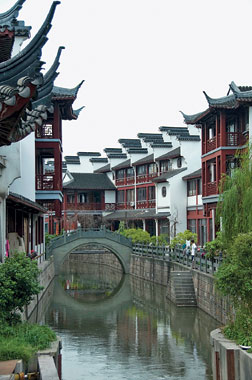
Songjiang district takes pride in its reputation as one of the authentic "roots" of Shanghai, with its people speaking a pure Shanghai dialect undiluted by influences from neighboring cities like Ningbo as the vast majority of Shanghainese do.
Located in southwest Shanghai, some 30 km from the downtown area, Songjian was originally set up in 751 AD under the Tang dynasty as a county called Huating. Since then it has enjoyed a rich and multifaceted history as the center of the region's politics, economy and culture prior to Shanghai's opening as a port city.
In recent years, old residential areas have become quite a tourist attraction in China, offering an alternative and more interesting vision of the past. Songjiang as a historical and architectural treasure trove unequalled in the rest of the municipality has also attracted an increasing number of visitors.
Songjiang Old Street
The buildings in Songjiang's Old Street are at least twice as ancient as the ones that tourists flock to see in Zhouzhuang in Jiangsu province, two hours outside Shanghai. Songjiang's buildings are also said to be more beautiful and in better shape than Zhouzhuang's, and are a unique part of Shanghai's history.
Songjiang is also home to a number of more recognized, and thus protected, sites. The oldest of these is the Toroni Sutra Stele, which dates from the Tang Dynasty (859 AD) and is located in a primary school. The 9.3-meter stele is rather dilapidated, but it is interesting to recall that it has been here since before downtown Shanghai was even so much as a landmass. There are five ancient pagodas in Songjiang: Square Pagoda, Xilin Pagoda, Huzhu Pagoda, Li Pagoda and Xiudaozhe Pagoda. The most famous is the Square Pagoda, a nine-story pagoda (42.5 meters high) that has inherited the style of Buddhist square pagodas from the Tang Dynasty. It was constructed during the Song Dynasty and is situated in a park containing many somber and simple buildings from that time.

Zhongshan Road forms Songjiang's main intersection. To the west lies Songjiang's most impressive and least-known attraction: the Old Street. Towards the end of the Old Street sits Xiling Pagoda, a 46.5-meter-high pagoda with a temple also from the Song Dynasty. Zuibai Pond, the residence of painter Dong Qiyuan that was originally built in the 18th century, features the precise baroque styles common to aristocratic residences of the Qing Dynasty.
After it was built in 1909, Songjiang Railway Station became a well-known example of "Western architecture with Chinese characteristics" and served as a favorite backdrop for films depicting the flight and dislocation of the 1930s and 1940s.